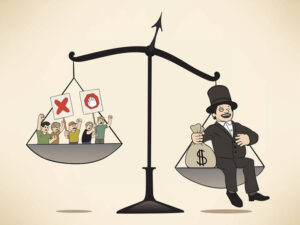Concept of Inequality
Relevant for Sociology Paper-1 (Unit-5)
Social inequality
- Concept of Inequality is a pervasive aspect of all societies, regardless of time or location. Personal attributes such as beauty, skill, physical strength, and personality can contribute to the perpetuation of inequality. However, there are also patterns of inequality associated with the social positions individuals hold.
- Two types of Concept of Inequality can be identified: natural and man-made. Natural inequality pertains to inherent differences such as age, sex, height, weight, etc., while man-made inequality can take the form of horizontal or vertical disparities. When occupational groups evolve into social groups with hierarchical placement and interactions within and between strata, this type of inequality is referred to as social inequality.
- The Concept of Social Inequality in the Analysis of Social Stratification: Social inequality refers to inequalities that are socially constructed. Social stratification is a specific form of social inequality, characterized by the presence of social groups ranked according to the power, prestige, and wealth held by their members. Those belonging to a particular stratum share a sense of common interest and identity, as well as a distinct lifestyle that sets them apart from members of other social strata. In traditional Hindu society, for instance, there were five main strata: the four Varnas and the outcaste or untouchables, arranged in a hierarchical structure with Brahmins at the top and untouchables at the bottom. Earlier thinkers perceived such inequality through various lenses, including economic, political, and religious dimensions.
- Plato was among the first to acknowledge the inevitability of inequality and propose ways to alter the distribution of money, status, and power for the betterment of both individuals and society. His envisioned society was explicitly class-structured, with citizens belonging to one of three classes: ruling, non-ruling, or auxiliary workers. Plato advocated for the elimination of inherited class status and the provision of equal opportunities regardless of birth.
- Aristotle, too, expressed concern about the consequences of inequality in terms of birth, strength, and wealth. He identified three classes: the very rich, the very poor, and the moderate.
- Thomas and St. Augustine distinguished individuals based on power, property, and prestige.
- Machiavelli explored the question of who is fit to rule and what form of governance can bring about order, happiness, prosperity, and strength. He recognized the tension between the elite and the masses, and leaned toward democratic rule. Machiavelli supported the idea that inequality in certain situations is legitimate as long as there is equal opportunity to become unequal.
- Thomas Hobbes posited that all individuals share an equal interest in acquiring power and privileges, which leads to chaotic conditions unless they agree to abide by a set of rules. These rules form a “Social Contract,” through which people grant authority to a ruler who upholds collective desires and will. The sovereign can be removed if they fail to maintain equality for the safety of all individuals.
- Max Weber emphasized the existence of three types of groups characterized by different forms of inequality, which can operate independently of one another. Weber identified three types of market situations: the labor market, the money market, and the commodity market. He referred to the second form of inequality as social honor or prestige, and the third form as power.
- Social stratification involves a hierarchy of social groups, as exemplified by castes. Members of a specific group share a common identity, similar interests, and a comparable lifestyle. They experience the unequal distribution of rewards within societies as members of different social groups.
- However, social stratification represents just one form of social inequality. It is possible for social inequality to exist without the presence of social strata. While many sociologists use the terms inequality and social stratification interchangeably, social stratification is considered a particular manifestation of social inequality.

Some Salient Aspects of Social Inequality:
-
- Social inequality arises from the differentiation that occurs within all societies. Various characteristics, such as age, gender, religion, physical strength, or educational achievement, lead to differential treatment of individuals. This differentiation ultimately results in inequality.
- Social inequality is a universal phenomenon. In every society, individuals do not receive equal recognition. Differences in status exist across societies, regardless of their size, level of modernity, or historical context. Social inequality becomes apparent when certain groups are valued over others, such as men over women, the rich over the poor, or one religious or ethnic group over another. Those with higher status enjoy greater access to societal rewards, while those with lower status are deprived of these advantages.
- Social inequality is inherently embedded within the social structure of modern societies. It takes on a more elaborate and structured form, with different categories of people occupying different statuses. Inequalities are inherited across generations, as social statuses are perpetuated. Society is stratified, resembling layers of rock, with each stratum offering different levels of access to social rewards.
- The presence of social inequality gives rise to social conflict and drives social change. Throughout history, social inequality has fueled tensions, revolutions, and transformative shifts in societies. It has sparked conflicts between oppressed and dominant groups, be it slaves and masters, peasants and nobles, or workers and capitalists. Karl Marx’s Communist Manifesto in 1848 brought the issue of social inequality to the forefront of political debates, and since then, these tensions and conflicts have gained global significance. Social inequality is closely intertwined with other societal issues, including social instability, economic fluctuations, political conflicts, potential violence, status insecurities, fear, and uncertainties.
- The sustainability of social inequalities is often rooted in the power of ideas rather than sheer force. These inequalities persist due to the acceptance of ideologies that justify and naturalize them. Both dominant and subordinate groups tend to unquestioningly adopt ideologies that uphold and legitimize inequalities. Traditional gender roles exemplify how established roles have perpetuated male dominance over women. Similarly, the caste system in India illustrates how higher castes traditionally dominate lower castes based on ascribed superior status.
- Social inequalities do not necessarily stem from natural or biological differences. Many stratification systems are accompanied by beliefs that attribute social inequalities to biological factors. For example, some groups claim biological superiority over others, using this as a basis for their dominance. However, most sociologists argue that socially constructed inequalities form the primary basis for systems of social stratification. The belief in natural or biological inequalities serves as a rationalization to justify the existing stratification system, making social inequality appear rational and reasonable.
- Currently, sociological research continues to explore the existence of inequality, its causes, and its consequences, focusing on social class, gender, ethnicity, and even regional or local disparities. Understanding social inequality remains a central topic in the field of sociology.
To master these intricacies and fare well in the Sociology Optional Syllabus, aspiring sociologists might benefit from guidance by the Best Sociology Optional Teacher and participation in the Best Sociology Optional Coaching. These avenues provide comprehensive assistance, ensuring a solid understanding of sociology’s diverse methodologies and techniques
Concept of Inequality, Social Inequality, Natural Inequality, Man-made Inequality, Social Stratification, Plato, Aristotle, Machiavelli, Thomas Hobbes, Max Weber, Caste System, Gender Roles, Karl Marx, Social Conflict, Sociology.
Follow us :
🔎 https://www.instagram.com/triumphias
🔎https://www.youtube.com/c/TriumphIAS
https://t.me/VikashRanjanSociology
Find More Blogs
|
Scope of the subject and comparison with other social sciences |
|||
|
|
|
|
Modernity and social changes in Europe |


